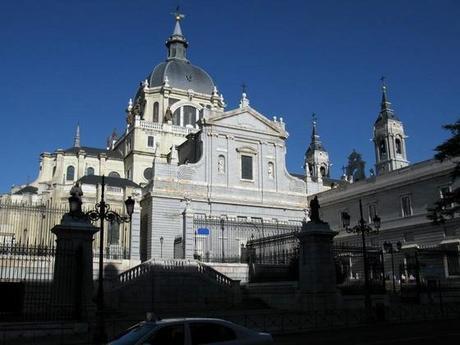Almudena Cathedral
The principle church of the Diocese of Madrid, the Catedral de Santa María la Real de la Almudena, is a relatively modern building, started in 1883 and not completed until 1993. Remarkable as it may seem, the delay until such recent times in the building of a cathedral in the capital can largely be attributed to the fact that Madrid was part of the Archdiocese of Toledo, which was reluctant to relinquish it.
When the capital of Spain was transferred from Toledo to Madrid in 1561, the seat of the Church in Spain remained in Toledo; so the new capital – unusually for a Catholic country – had no cathedral. Plans were discussed as early as the 16th century to build a cathedral in Madrid dedicated to the Virgin of Almudena, but construction did not begin until 1879.
The cathedral seems to have been built on the site of a medieval mosque that was destroyed in 1085 when Alfonso VI conquered Madrid.
Francisco de Cubas, the Marquis of Cubas, designed and directed the construction in a Gothic revival style. Construction ceased completely during the Spanish Civil War, and the project was abandoned until 1950, when Fernando Chueca Goitia adapted the plans of de Cubas to a baroque exterior to match the grey and white façade of the Palacio Real, which stands directly opposite. The cathedral was not completed until 1993, when it was consecrated by Pope John Paul II. On May 22, 2004, the marriage of Felipe, Prince of Asturias to Letizia Ortiz Rocasolano (known thereafter as Letizia, Princess of Asturias) took place at the cathedral.
The Neo-Gothic interior is uniquely modern, with chapels and statues of contemporary artists, in heretogeneous styles, from historical revivals to "pop-art" decor.
The Neo-Romanesque crypt houses a 16th century image of the Virgen de la Almudena. Nearby along the Calle Mayor excavations have unearthed remains of Moorish and medieval city walls.
On the 28th of April 2004, Cardinal Antonio María Rouco Varela, Archbishop of Madrid blessed the new paintings in the apse, painted by Kiko Arguello, founder of the Neocatechumenal Way. The cathedral is the seat of the Patriarch of the Indies and the Ocean Sea, an honorific patriarchate created in the sixteenth century, and subsequently an honorific title for the Spanish court's chaplain.
Plans for the building were, however, progressed when Pope Leo XIII separated the capital from Toledo in the creation of the Diocese of Madrid-Alcalá. Until the current building was completed, the Cathedral was temporarily housed in the Jesuit College church of San Isidro. Alumeda was finally consecrated in 1993 by Pope John Paul II, and remains the only Spanish cathedral to have been consecrated by a Pope.
The cathedral is consecrated to Santa Maria de la Almudena, a name which has Arabic origins: al mudayna, means "the castle". Legend has it that in the 8th century, when the Moors invaded the fortress where Madrid now stands, the people hid an image of the Virgin in the city walls, and only when the city was reconquered in the 15th century did a wall crumble to reveal her presence once again. Some versions suggest that the legendary el Cid found the image in the wall, and the Virgin helped him to retake the city.
The building is a mixture of styles with a neoclassical exterior, a gothic revival interior, and a neo-romanesque crypt. It is constructed of granite and marble, with a large neoclassical cupola and two towers at the main entrance. The Catedral de Santa María la Real de la Almudena sits next to the Palacio Real, separated from it by a spacious square, the Plaza de la Armería.
Unusually for a church, it is not oriented east and west, but has its orientation north and south, as it was originally conceived as an integral part of the Royal Palace complex. A second entrance, in the Calle Bailén, has impressive bronze doors by the sculptor Sanguino, depicting the discovery of the image of the Virgin.
The nearest Metro station is Opera, and the Cathedral is open to the public from 10am to 7.30pm, though it is closed to visitors during Mass. On Sundays, it is open from 10.30 to 12 midday, and in the afternoon from 1.30pm to 7pm. You can get there via flight to Madrid.



